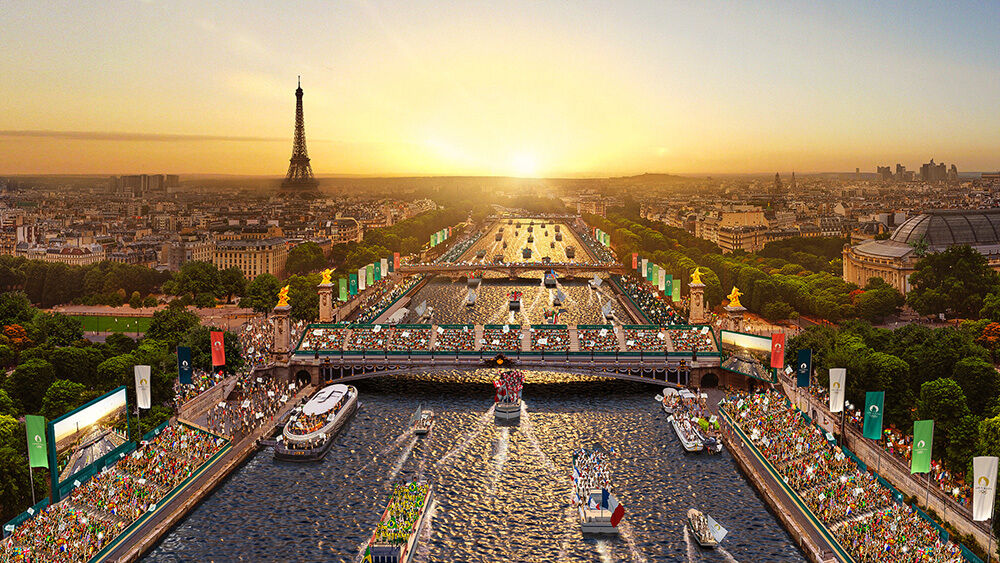
The first non-stadium setting for an opening ceremony in the history of the Summer Olympic Games, the Paris 2024 Opening Ceremony will form a nearly four-mile-long procession along the Seine, allowing for hundreds of thousands of spectators to take part. (Photo rendering by Florian Hulleu ©Paris 2024)
In ways both small and large, the Paris 2024 Olympic and Paralympic Games is a series of firsts. It will be the first in the history of the Games to include breakdancing (or “breaking”) as a competitive event, and the first to achieve gender parity. Paris 2024 may also achieve the Games’ highest level of sustainability yet by becoming the first to halve its carbon emissions compared to the average of London 2012 and Rio 2016.
The goal has been years in the making, set in motion by the International Olympic Committee (IOC) — the Lausanne, Switzerland–based body that oversees all matters related to the Games and the Olympic Movement at large — and the IOC’s Olympic Agenda 2020, a roadmap that spells out its broader goals. Sustainability is a key pillar of that roadmap. The IOC has committed to reducing its direct and indirect emissions by 50 percent by 2030, when all Olympic Games must also commit to reducing carbon emissions and compensate for more than 100 percent of their residual emissions.

Marie Sallois
“Paris 2024 is the first edition to fully embrace this ambition of the strategic roadmap,” Marie Sallois, IOC’s director of corporate and sustainable development, told Convene. “From Day One, [Paris 2024] was conceived with sustainability in mind.” In fact, the Paris 2024 Organizing Committee — the body responsible for planning, organizing, financing, and delivering the Olympic and Paralympic Games in Paris in 2024 — pledged to halve carbon emissions during its bid, in step with the Paris Agreement on Climate Change.
That goal initiated a complete overhaul of the Games’ sustainability strategy, chiefly switching from a post-Games assessment to setting a pre-Games target and defining a carbon budget early on: less than 1.7 million tons of CO2. This carbon budget is treated much like a financial budget, where “every decision you make about an event, an activation,” Sallois said, “you must take into account how much it costs, how many people will work on it, and how much carbon it emits.”
“That’s a very different approach than the one we took in the past,” she said. Although many editions of the Games had “interesting, innovative solutions in terms of sustainability” — Sallois cited the 2020 Summer Olympics in Tokyo, which embraced circularity with recycled Olympic Medals and podiums — for Paris 2024, she said, “sustainability was first and foremost.”
Come July 26, 2024, when the opening ceremony kicks off, spectators and athletes will see this new iteration of the Games come to life, one where nearly every facet of the experience has been revised to lessen its environmental impact. “Some things are incremental, some things are drastic,” Sallois said. But overall, the strategy has been to “look at… the levers that contribute the most to the footprint.”
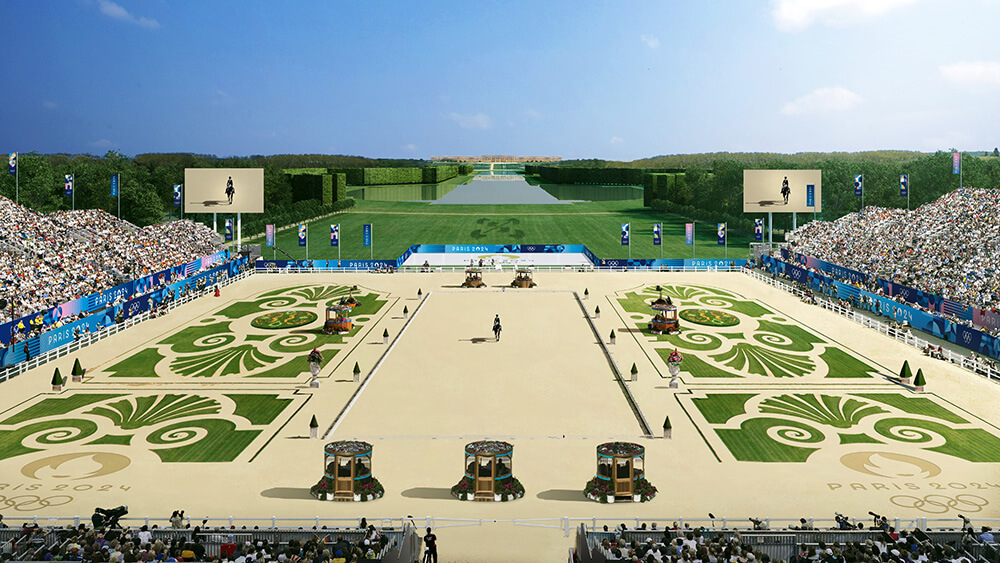
Château de Versailles’ famous gardens will be one of several historical landmarks in Paris and throughout France that will act as backdrops for the Paris 2024 Olympic and Paralympic Games, including the equestrian, para equestrian, and pentathlon competitions. Pictured is a rendering of a temporary arena setup for equestrian events on the palace’s Etoile Royale esplanade. (©Paris 2024)
Second Life
Of those levers, infrastructure ranks as one of the largest. Already, Paris 2024 has achieved a new benchmark in this category — 95 percent of the venues for the Games will utilize existing or temporary structures, the highest percentage of any previous Olympic Games. That includes historic sites that have been modernized — like Yves-du-Manoir Stadium, which served as the main venue for the eighth Olympiad in 1924 and will host the field hockey competitions for Paris 2024 — and temporary facilities, like an outdoor arena that will host the Olympic and Paralympic equestrian jumping and dressage competitions on the Etoile Royale esplanade at Château de Versailles.
The design of the new Aquatics Centre, the only permanent sports facility built for Paris 2024, meets stringent environmental standards. It has been built primarily with wood rather than concrete or steel, both of which create carbon dioxide in their manufacturing process, and will require less cooling and heating, aided by the rooftop solar array. The Olympic and Paralympic Village also demonstrates how infrastructure for the Games can be built using sustainable construction methods to lower emissions. Stretching into the neighborhoods of Seine-Saint-Denis, Ile Saint-Denis, and Saint-Ouen, the 126-acre site will accommodate 14,500 athletes and their staff during the Olympic Games followed by 9,000 athletes and their staff during the subsequent Paralympic Games. The Village’s carbon footprint is also 30 percent smaller than that of a modern construction project as a result of using wood and recycled materials. The latter, Sallois said, represents how the Village exemplifies “how we want to build for the future,” by not just focusing on lowering carbon emissions, but creating climate-resilient infrastructure.
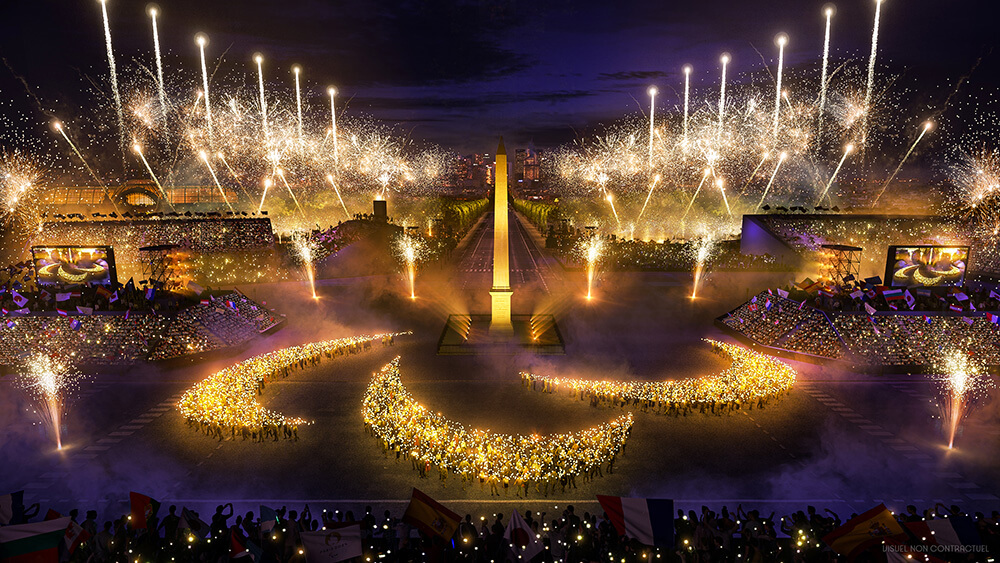
On Aug. 28, 2024, more than 4,400 athletes will parade down Champs-Élysées Avenue to Place de la Concorde for the Opening Ceremony of the Paris 2024 Paralympic Games. In addition to an expected record-breaking attendance of 3.4 million spectators, the Paris 2024 Paralympic Games will mark the first time that all Paralympic sports are filmed and broadcast live. (©Paris 2024)
Power On
Powering Paris 2024 infrastructure using renewable energy — like the geothermal-powered Olympic Village — will be a first for the Games, Sallois said, and what she thinks holds significant potential for the events industry at large. “Often in the past, the model for large events — and this is true for events other than sporting events — [is diesel] generators as a primary source of energy,” she said.
Instead, a newly created grid operated by French partner Enedis and EDF will supply Paris 2024 venues with energy produced via off-site wind and solar farms. According to the IOC, it will save 14,000 tons of carbon emissions. And it’s also permanent, helping to further the legacy of Paris 2024 by allowing future events to harness renewable energy, too — an idea that Sallois believes represents “a big shift for the industry of events.”
Solar energy generated on site also is helping to power the event. The Aquatics Centre’s photovoltaic panel-covered roof is intended to supply all of the facility’s energy needs and also will qualify as one of France’s largest urban solar farms. Similar installations will be added to the Olympic Village, the Transport Mall, and even the Seine, where a floating solar power plant with 7,750 square meters will supply energy to the Games and will be repurposed elsewhere later. Even the backup generators — essential in the event of interruptions in energy supply — will run on biofuels.
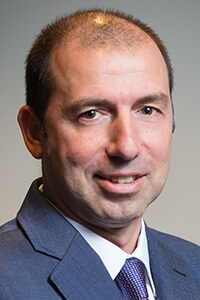
Panos Tzivanidis
Getting Around
It helps that Paris is already one of the most walkable cities in the world, which is further bolstered by a robust public transportation system and the fact that many of Paris 2024’s major venues will be centrally located within the city.
“Paris, together with IOC, has completely revisited … transportation operations and the transportation plan to not only use the most efficient transportation means from a sustainability point of view, but also to reduce, in total, the [need for] transportation,” said Panos Tzivanidis, the IOC’s director of corporate events and services.
For Paris 2024, venues have been cherrypicked for their proximity to public transport — even beyond Paris. Lyon, Saint-Etienne, Nice, Bordeaux, Nantes, and Marseille will all serve as Olympic host sites in 2024, with France’s high-speed TGV rail network connecting spectators to those cities and other Olympic sites around France. Within Paris, those spectators will have the Paris metro to rely on, which has expanded routes for the Games, along with nearly 260 miles of bike lanes, including 54 miles of recently added lanes that will create new access points to competition venues. Thousands of extra bikes will be available for spectator use via Vélib, a public bike-sharing program. In addition, Toyota will provide a fleet of electric- and hydrogen-fueled transportation options on hand for athletes, staff, and spectators.
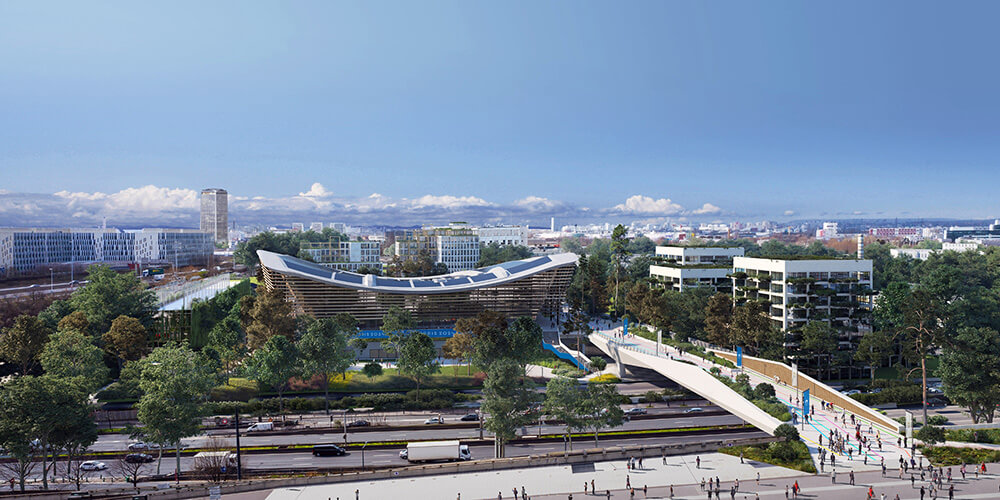
Constructed of timber and other low-carbon materials, The Aquatics Centre is also topped with a photovoltaic panel-covered roof. A new footbridge will connect the center with Stade de France, the national stadium of France. (MGP/©Paris 2024)
Leaving a Legacy
“Paris 2024 is really a turning point in our approach [to legacy] because now it’s really us adapting to the city, and no longer the [city] adapting to us,” Sallois said. That includes ensuring new infrastructure can be purposefully adapted and tailored to the needs of the host destination in the afterlife of the Games — a key goal laid out in the IOC’s Olympic Agenda 2020.
For example, the Aquatics Centre intends to benefit the residents of Seine-Saint-Denis, an area in Northeast Paris. During the Games, the Aquatics Centre will host the artistic swimming, water polo, and diving events but after it will provide a dedicated facility for the community — a huge asset considering that it’s an under-resourced area in terms of infrastructure and that six out of 10 teens in the area do not know how to swim. In addition, the Olympic Village site will provide the local community with more than 2,800 new housing units, two new schools, 14 acres of green space, and a new bridge crossing the Seine that links the Île-Saint-Denis and Saint-Denis neighborhoods, among other infrastructure.
For Paris 2024, legacy also goes beyond infrastructure. Paris 2024 “has a very clear legacy that has been already delivered prior to the Games,” Sallois said. “It means that the legacy is not something that you think about during the Games or after, you plan for it… to be delivered before the Games.” A prime example is Paris 2024’s commitment to motivating the country’s youth to exercise more. According to the National Observatory of Physical Activity (ONAPS), 37 percent of children between 6 and 10 years old and 73 percent of 11- to 17-year-olds do not get the recommended minimum of 60 minutes of daily physical activity. Paris 2024 has been successfully advocating for this cause through various initiatives, including convincing 36,250 French primary schools to add 30 minutes of movement to their daily schedule. “We are currently running a survey in one of the cities where these different measures have been introduced,” Sallois said, “and we know already that it has had an impact on the concentration, for instance, of kids at school.”
Sallois also pointed to how Paris 2024 has provided more economic opportunities to local businesses and organizations. According to the IOC, “early planning before the election of Paris 2024 as an Olympic host showed that the Games would generate activity for 181,000 jobs in a wide range of areas, including event organization, tourism, catering, and construction.” To streamline the process of applying for these opportunities, Paris 2024 created a new platform to ensure small businesses could compete with those with larger resources, Sallois said. This is part of a social charter solidified in 2018 between local trade unions and employer organizations, a first in Olympic history, to open up more opportunities and resources for job seekers and small businesses.
The result? “Ninety percent of the suppliers for Paris 2024 are French, and 75 percent of them are small- and medium-sized organizations,” Sallois said. “This is a big achievement — [especially] for the smaller businesses, because they have gained skills and a competitive advantage.”
Looking Ahead
Sallois emphasized that flexibility — the ability to adapt to the host territory — will continue to be key to future Olympic Games. Paris is “a very old city with a lot of existing infrastructure,” she said, and with L.A. 2028, “you’re again in a very large city with a lot of infrastructure and this is why they decided to go to a radical reuse approach — no new venues will be built.” The Olympic Village will use the UCLA campus, she said, “so it’s really a radical shift.”
One difference between L.A. and Paris is that travel by car is heavily favored in L.A, but Sallois is undeterred. “Still, we can innovate,” she said. For example, buses can be low-carbon buses. “We will find solutions, we just need to work with the constraints we have in a certain geography,” she said, but that often just means “we will innovate even more. I mean, because the Games take place every four years, by the time we reach Los Angeles, there will be new solutions on the market.”
 Setting the Standard
Setting the Standard
Using Paris 2024 as a test pilot, the IOC and other entities worked with the Organisation for Economic Co-operation and Development (OECD) to develop a new methodology for evaluating the social, economic, and environmental benefits of events. Guidelines based on this new methodology were released by the OECD in late 2023 for organizers to use for their own events, which can be downloaded in two parts: How to Measure Impact and Impact Indicators. Paris 2024 also has inspired another new set of guidelines — an updated ISO standard for managing the social, economic, and environmental impact of events, set to be released just prior to Paris 2024’s kickoff.
For London 2012, “we released for the first time ISO 20121, and now with Paris we are aiming at releasing the new version that will [reach] another level,” IOC’s Marie Sallois said, adding that the updated standard will put a greater emphasis on human rights, social justice, and legacy. The IOC’s Panos Tzivanidis said that the certification is “an important milestone” for not just Paris 2024, but for the IOC’s institutional events at large. “It ensures that every event we touch is aligned with our vision for a greener and more sustainable future.”
 A Second Opinion
A Second Opinion
“An evaluation of the sustainability of the Olympic Games,” a study published in the April 2021 issue of online monthly journal Nature Sustainability, ranks Olympic Games — specifically those held between 1992 and 2020 — as only marginally sustainable. The study’s authors collectively rank the Games as “medium” — 48 out of 100 possible points on the scale devised for the study.
Broadly, the study states that it defines a “sustainable Olympic Games” as having three dimensions: “having a limited ecological and material footprint, enhancing social justice, and demonstrating economic efficiency.” According to the study, the Games could improve its marks by drastically reducing the size of the event, rotating the event between the same cities to reduce waste from building new infrastructure, and create an independent body to develop and enforce new sustainability standards. However, such actions come with obstacles, including a significant reduction in revenue from downsizing.
But the potential to make a positive impact — beyond the Games themselves — is huge. As the Nature Sustainability study points out, “together with their exceptional visibility, the Olympic Games provide a unique platform to reach a global audience and could serve as a model for cities, countries, and other events around the world to emulate.”
Jennifer N. Dienst is senior editor of Convene. Illustrations by Serge Bloch.
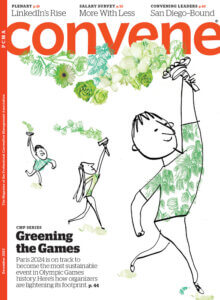 More Paris 2024 Games Coverage
More Paris 2024 Games Coverage
These stories are all part of the December 2023 Convene CMP Series and cover story. Convene will periodically check in with the progress of next year’s Olympic Games, one of the largest events in the world.
- The Seine’s Starring Role in the Paris 2024 Olympic Games
- Paris 2024 Olympic Torch’s Modern Makeover
- Sustainability Isn’t the Only Goal on 2024 Olympic Games’ Agenda
Earn CMP Credit
Earn one clock hour of certification by visiting pcma.org/convene-cmpseries to answer questions about this article and a recent article by LAist, “How A Conference About Climate Change Tackled Its Own Food Waste (But Didn’t Skimp on the Coffee),” at convn.org/climate-food.
The Certified Meeting Professional (CMP) is a registered trademark of the Events Industry Council.
